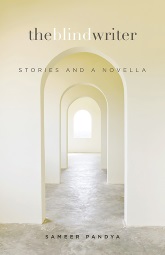The Blind Writer
Sameer Pandya

Paperback: 216 pages
|
The sheer breadth of the South Asian American community has allowed us to forge a common identity as Americans descended from the Indian subcontinent, and yet simultaneously gives us the platform to be Gujarati or Tamil, Bhutanese or Pakistani, Kshatriya or Brahmin, in America. Sameer Pandya’s The Blind Writer is a cogent document of this South Asian American experience and those things that bind us all together, especially for my generation that came of age in the ‘70s and ‘80s. This collection of five short stories and one novella documents it all: the spelling bees; dot matrix printers no one wanted to throw away; suburban dreams; vegetarian tailgating; dating debacles; ubiquitous desi-owned liquor stores; constant parental pressures to get a degree at a “good school”; and parties where the adults, mostly white-collar professionals, got hammered and ate Indian food upstairs while the kids watched cartoons and ate American food downstairs. These memories were part of all of our lives, whether through our lived experiences, or those of our friends, and Pandya masterfully manages to capture these times and places. And yet, The Blind Writer is not a book by an Asian Pacific American writer about his Asian immigrant upbringing. With the exception of “M-o-t-h-e-r”, the first story in the collection, Pandya, who teaches literature and creative writing at the University of California, Santa Barbara, focuses on men, and all of their confusions, infatuations, unforgiving stubbornness, and almost pathetic insecurities. This book is less about South Asians and the Indian-American experience, as it is about Indian-American men, and their (in)abilities to navigate life. Then men in this collection—Rakesh, Mahesh, Vikram, Ajay, Arun, Anil, and Sunil – represent so much of what it means to be a man, and the confusion over how we represent ourselves. It’s like Pandya channeled Eliot’s Prufrock and his advice to “prepare a face to meet the faces that you meet.” They cheat on their partners, yet feel jealous when their exes move on. They hesitate to commit to long-distance relationships, yet presume that the women they have left behind will be their safety nets. Their interactions are self-serving and often driven by pure lust and emotion. Every man could see himself in these characters. One story in particular, “Ajay the Lover”, really moved me. There was so much about the character that was annoying, but Pandya’s pellucid depiction of Ajay’s faltering attempts at navigating the India-America cultural tightrope when it comes to dating and relationships stuck a real chord. I hated the man, but could also empathize because I knew that pain. When he meets Rachel, a Jewish woman, seemingly perfect in every way, Ajay just cannot close the deal. Writes Pandya,
I recently attended a reading by Pandya and pointedly asked him about the North Indian feel of the book, and if it was on purpose. He enthusiastically replied in the affirmative, adding later that the characters and experiences of his own Gujarati immigrant childhood formed the basis for much of his fiction, and that even his vivid descriptions were in contrast to his almost austere, simple, and Gandhian upbringing. This is a crucial point in understanding the author’s style, because his greatest strength is the prose, and the delicious and well-crafted morsels he drops along the way. It’s almost as if he kept a book of one-liners and threw them in during his writing process. For example, he perfectly describes dining out in New York as: “The restaurant was half full and had that sadness that vegetarian restaurants – with their limited, peculiar clientele – have on a cold winter evening, a few days shy of a major holiday.” The same with the woman the narrator leaves behind: “You know, even California stops being beautiful if you stare at it for too long”); and the pithy advice from a would-be writer “When I was a graduate student, preparing for a career I would eventually abandon.” While The Blind Writer is Pandya’s first published collection of fiction, the university lecturer by day has already built up a solid reputation as a sports writer and essayist forSpin, The Atlantic, ESPN, Sports Illustrated, and The Pacific Standard. We can only hope that Pandya continues to push the creative envelope by delving into his cultural past, but not to share the common tropes that many have come to associate with the immigrant voice; rather, Pandya’s gift is in his ability to pencil in characters whose ethnicity is only part of their story. In this way, Pandya’s work allows us to come full circle as the children of immigrants, and embrace our Americana, predicated as it is, on our otherness.
|

 Sameer Pandya
Sameer Pandya The Spelling Bee: America’s Great Racial Freaks-and-Geeks Show by Sameer Pandya
The Spelling Bee: America’s Great Racial Freaks-and-Geeks Show by Sameer Pandya